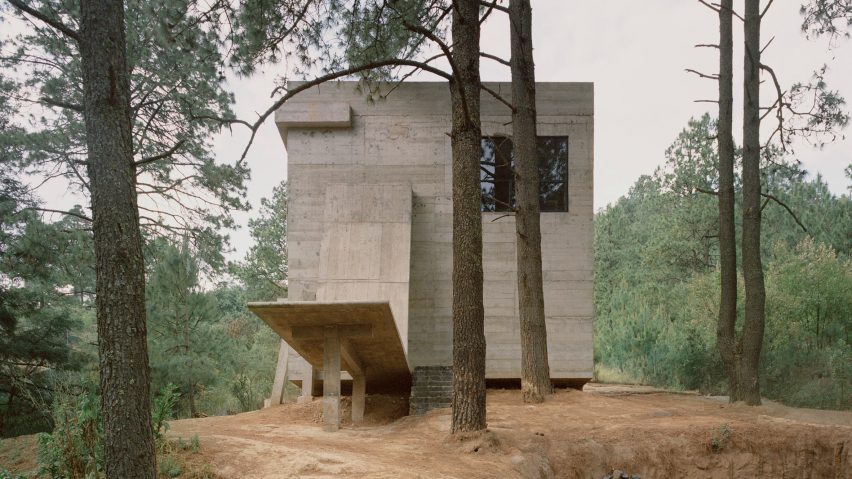A holiday home punctuated by arches in Tulum and a "rugged" home in Argentina are among the projects in this roundup, which centres on brutalist houses in Latin American countries.
Although brutalism emerged out of western Europe in the 1950s and 60s, the movement spread to countries in Latin America in the 1960s and 1970s.
Here, modernist Brazilian architects Paulo Mendes da Rocha, Lina Bo Bardi and Argentinian studio Luciano Kruk embraced the style.
Characterised by simple but imposing forms and the use of raw concrete – the French term for which, beton brut, gives the movement its name – brutalism is a rejection of ornamental architecture.
In Latin American countries, the continent's tropical landscape often provides a welcome contrast to the grey, urban forms and helps create a refreshing environment that critics have dubbed "tropical brutalism".
Read on for eight houses in Latin America that typify the style:
Casa Alférez, Mexico, by Ludwig Godefroy
Aptly named Casa Alférez given its location in the Alférez region of Mexico City, this two-bedroom holiday home by local architect Ludwig Godefroy has many parallels with a protective shelter.
Its angular shape, narrow windows and solid concrete walls protect holidaymakers when inside while from the outside, the stark cube looks impenetrable.
Find out more about Casa Alférez ›
Pedro Reyes Studio, Mexico, by Pedro Reyes
Mexican architect Pedro Reyes owns and works in this brutalist, bunker-like studio, which is an extension of his stone and concrete home.
As it was built closely after the 2017 earthquake in Puebla, it needed to be constructed quickly, so Reyes chose to use prefabricated concrete panels.
"Being an expansion of the house, we wanted to have this kind of same palette of materials which is stone and concrete, yet within that palette we have a lot of different treatments that allow different textures and surfaces," he explained.
Find out more about Pedro Reyes Studio ›
Villa Petricor, Mexico, by CO-LAB Design Office
Perched on a slender, angled Tulum plot resplendent with lush vegetation, Villa Petricor was designed by CO-LAB Design Office. It is arranged around several clusters of trees, which can be seen through gothic arched openings.
Concrete blocks were used to create a distinctive brise-soleil screen on the entrance facade, which offers glimpses of within while providing privacy.
Find out more about Villa Petricor ›
PK Residence Annex, Brasil, by Reinach Mendonça Architects Associados
An angular concrete pavilion adds intrigue as well as a place for occupants to entertain guests at PK Residence Annex, a family home in São Paulo.
The geometric design, which was created by Brazilian firm Reinach Mendonça Architects Associados, compliments the slanted roof topped with grass and concrete pillars elsewhere in the building.
Find out more about PK Residence Annex ›
LBS House, Chile, by Umberto Bonomo and Felipe Alarcón
Chilean architects Umberto Bonomo and Felipe Alarcón constructed this property using cinder blocks, which were easy to transport and assemble on the remote coastal location. The material was selected for its contrast against the "megalithic" rocks scattered on the site.
The house is framed by two walls that meet at an acute V-shaped angle, with openings that let light and air through.
"Granitic rocks of megalithic appearance contrast with the industrial, porous and neutral cement blocks," they added.
Find out more about LBS House ›
Casa Mendes da Rocha, Brazil, by Paulo Mendes da Rocha
The late Pritzker Architecture Prize-winning architect Mendes da Rocha injected his trademark style into Casa Mendes da Rocha, a house he built alongside his sister's in Butantā, São Paulo.
It was designed to mirror the home Mendes da Rocha had built for his sibling, which features bulky, exposed concrete volumes.
Find out more about Casa Mendes da Rocha ›
Casa H3, Argentina, by Luciano Kruk Arquitectos
This two-storey summer house, which Argentinian studio Luciano Kruk Arquitectos completed in a pine wood near Buenos Aires, is wrapped in board-marked concrete.
The concrete gives the house what Kruk described as a "rugged" look and as it was left untreated, it will weather and blend in with the surroundings over time.
Two Houses Conesa, Argentina, by BAK Arquitectos
For this project, BAK Arquitectos added a robust concrete facade on the front of the two houses to give residents protection from traffic noise from the street below.
The street-facing elevation features surfaces formed from raw concrete and metal mesh that give the brutalist houses a hardy aesthetic.
Find out more about Two Houses Conesa ›

